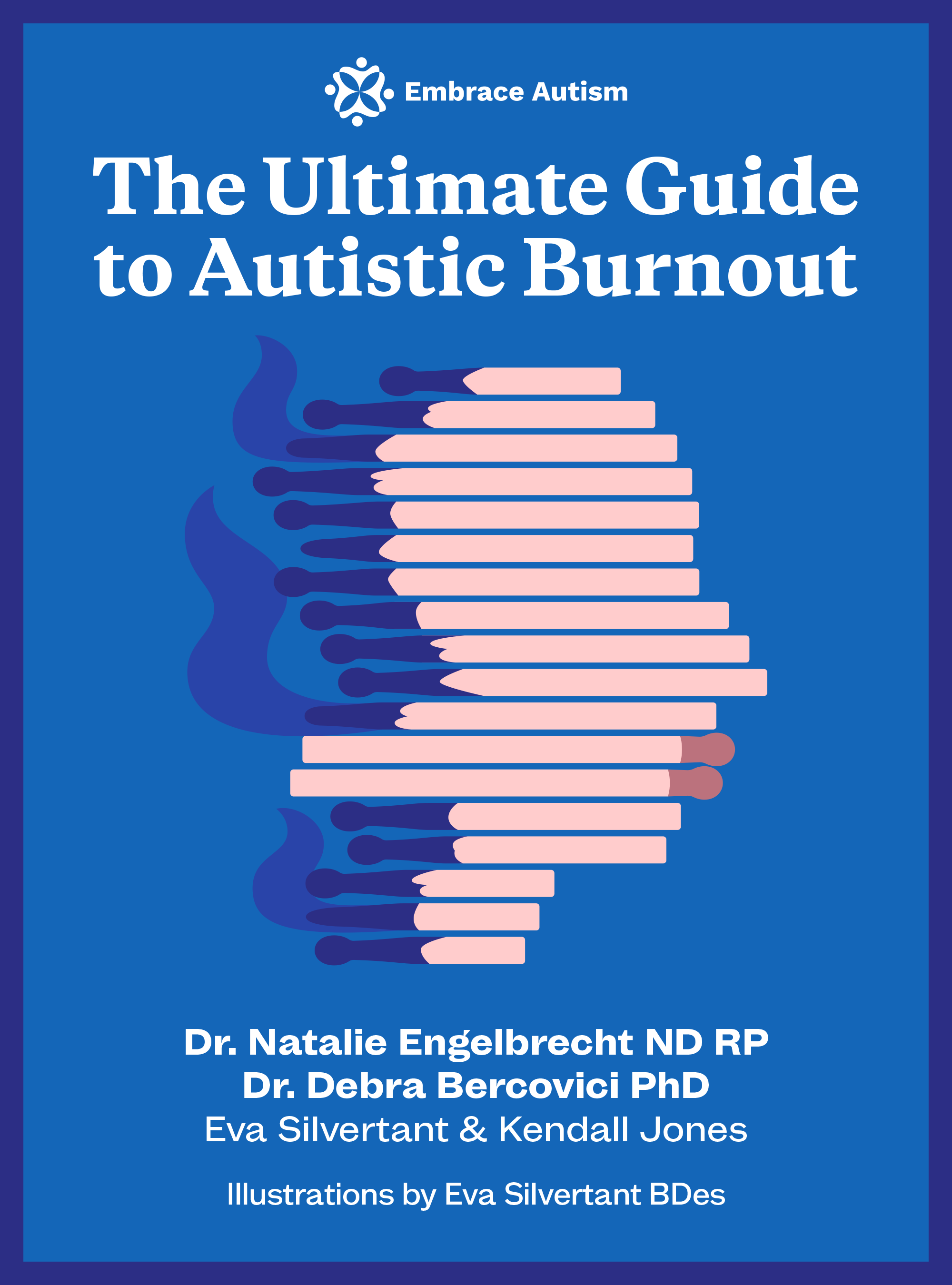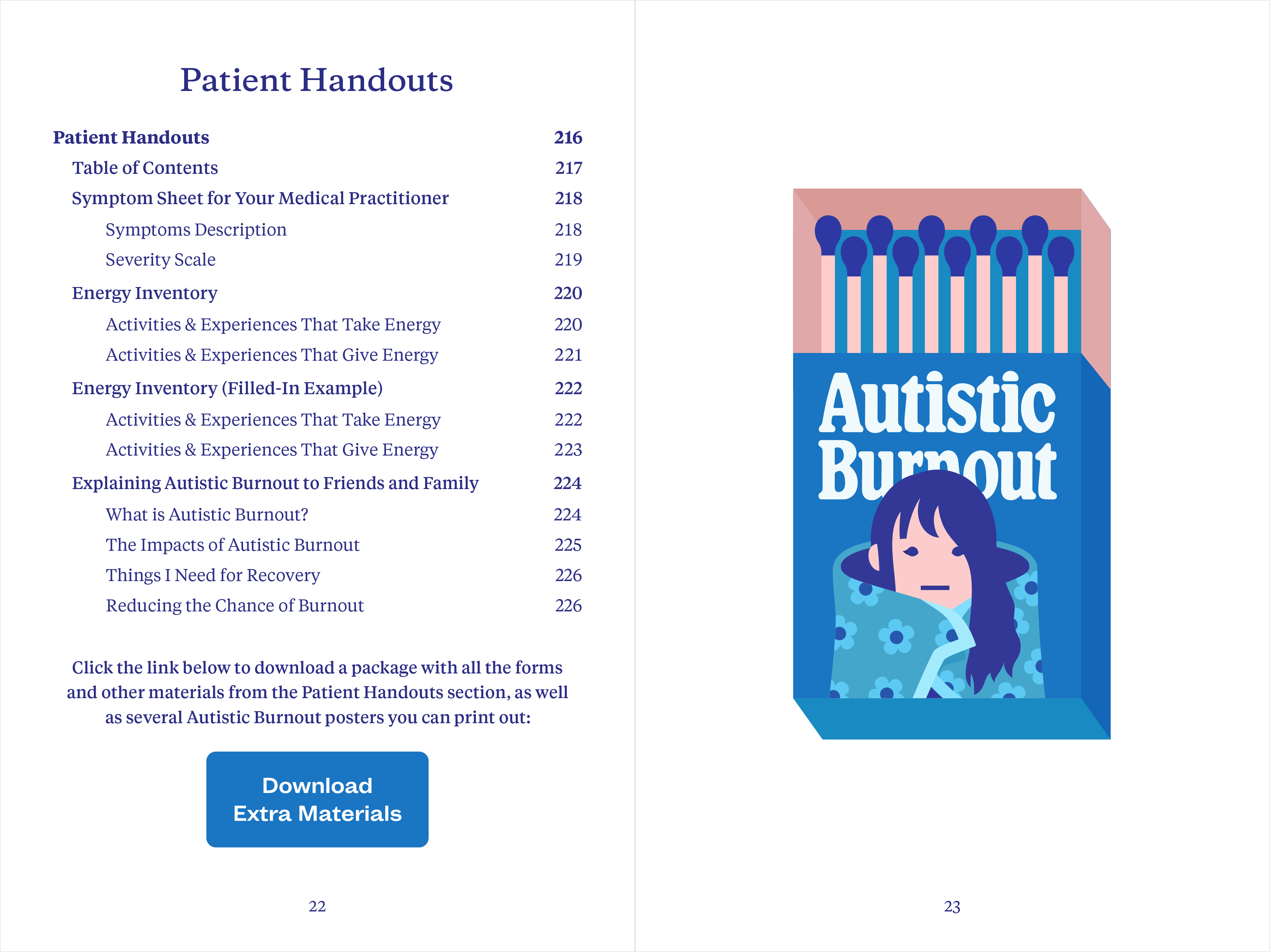After about 4 months of work, our highly anticipated book, ‘The Ultimate Guide to Autistic Burnout’ is out now! 😃
Autistics often describe feeling exhausted and depleted from living in a non-autistic world, as if all of their internal reserves have been used up. The medical field has finally recognized this condition as ‘autistic burnout’—a phenomenon that exclusively affects an astounding two-thirds of autistics, and carries with it severe risks of suicidal ideation, depression, and anxiety.
The Ultimate Guide to Autistic Burnout
The Ultimate Guide to Autistic Burnout summarizes and explains the most current research on the topic, and provides you with the tools to identify and recover from autistic burnout safely. The book is written by adult autistics and is based on research, clinical experience, and the lived experience of autistic people.
The Ultimate Guide to Autistic Burnout pulls together a scattered field and presents actionable information with a very compassionate and patient-centred approach.
Dr. Kathy Murphy
neuroscientist, late-diagnosed AuDHD

The book was researched and written by Dr. Natalie Engelbrecht ND RP (an authority in adult autism), neuroscientist Dr. Debra Bercovici PhD, Eva Silvertant, and Kendall Jones; and brought to life by award-winning graphic designer and illustrator Eva Silvertant BDes—making it a valuable resource for clinicians and the autistic community alike.
Format of the book
The book takes the reader through the causes, diagnostic criteria, and resources for prevention and recovery by incorporating the latest research and personal stories from many autistic contributors. It is relevant to healthcare professionals, autistic individuals, educators, and anyone curious about autism.
Clinical & non-clinical versions
To that end, the book is divided into two parts: a clinical version for medical professionals who would like to inform themselves about autistic burnout to better treat autistic adults who struggle with burnout; and a non-clinical version for autistic people and their loved ones, to better understand autistic burnout and what strategies could offer help—either through treatment by a medical professional, or things you can do yourself. The table below shows some of the features of the clinical and non-clinical versions.
| Clinical version | Non-clinical version | |
|---|---|---|
| Language | Clinical | Accessible |
| Content | For clinical use | For personal use |
| Descriptions | Descriptive, but aiming for brevity | Comprehensive explanations |
| Papers referenced | APA-style citations | Footnotes |
| Personal examples | ✗ | ✓ |
| Links to articles | ✗ | ✓ |
Note that it could be helpful to medical professionals to read the non-clinical version as well, since it offers personal accounts of autistic burnout.
File format & layouts
The e-book consists of around 227 pages (plus or minus a few pages depending on the format), and is currently available in PDF format, in two layout versions:
- Spread layout — Two pages side by side, which is better suited for desktops and tablets as it utilizes the horizontal space available
- Mobile layout — Single-page layout that makes optimal use of the screen area available on mobile phones
Below is an example of two pages from the book—the last part of my Autistic Burnout Story (i.e., my experience with autistic burnout).

Your purchase of the e-book will contain both layout versions.
The e-book will soon also become available in the single-page layout via Amazon (a Kindle edition) and Apple; and we are working on releasing a physical book via Amazon soon!
Contents of the book
As the title ‘The Ultimate Guide to Autistic Burnout’ suggests, we tried to be as comprehensive as possible about autistic burnout, making this the ultimate guide that summarizes the latest research and screening tools to measure and identify autistic burnout. There is currently no other source that compiled everything we know about autistic burnout in such a comprehensive manner.
Overview of subjects
In the table below, you can see an overview of all the subjects described in the book. Note that everything listed is described in both the clinical and non-clinical versions of the book—with extra explanations, links, and personal anecdotes in the non-clinical version.
| Subject/chapter | Description |
|---|---|
| Quick reference guide | The Quick Reference Guide offers a quick overview of autistic burnout for medical professionals, consisting of the formal definition, the diagnostic criteria, associated concerns to keep in mind (suicidality, depression, anxiety), psychometric tests to screen for autistic burnout, and treatment options. |
| Defining autistic burnout | An overview of the different aspects of autistic burnout and the diagnostic criteria used to diagnose it. |
| Epidemiology | The prevalence of autistic burnout, of autism (national estimates, global estimates, the gender ratio, the diagnostic gender bias, etc.), risk factors of autistic burnout, protective factors, and special cases. |
| Etiology | A comprehensive description of the different demands (social, sensory, cognitive, etc.) that contribute to autistic burnout. |
| Clinical approach | A comprehensive description of the clinical procedure for autistic burnout, including information on working with autistic clients, a suicide risk assessment, diagnosis of autistic burnout, psychometrics, and an extensive treatment protocol for autistic burnout. |
| Characterizing autistic burnout | A description of the signs of autistic burnout using the ECAO model, differential diagnoses (i.e., how to tell autistic burnout apart from other conditions that share features, such as depression, occupational burnout, and chronic fatigue syndrome), and the consequences of autistic burnout. |
| Autistic burnout stories | Personal stories of autistic burnout from 16 autistic people, including descriptions of their particular challenges, and things that improved their burnout. |
Supplementary materials
The Ultimate Guide to Autistic Burnout comes with a toolkit consisting of various forms to facilitate conversations on autistic burnout with your medical professional or your family. It will come with the following:
| Patient Handout | Content | Description |
|---|---|---|
| Symptom Form for Medical Visit | Symptom Sheet | The Symptom Sheet is a form you can fill and bring to your doctor or other medical professional, to communicate a symptom you’re dealing with (whether autistic burnout or other psychological or physical symptoms) and its particular features (onset, duration, intensity, etc.). In the non-clinical version of the book, Dr. Natalie Engelbrecht ND RP offers a filled-in version of the Symptom Sheet which she brought to her doctor, so you can get a sense of how you could use this form. |
| Symptom Form for Medical Visit | Severity Scale | The Severity Scale is part of the Symptom Sheet but can also be used separately. It gives an overview of the different intensity levels of a symptom, which could be useful in communicating the severity of a symptom to your medical professional. This could be particularly useful for autistic people with alexithymia who have difficulty describing their symptoms in a nuanced way, but there is also a general tendency for autistic people to underreport symptoms. For instance, when conveying the experience of pain, we may argue that the potential intensity of pain is far above what we’re experiencing now, and thus rate our pain as a 4, 5, or 6 where a neurotypical would rate it as an 8. This can lead to our symptoms not being taken seriously. The Severity Scale tries to address this by offering clear descriptions for each severity rating, so as to remove or reduce subjectivity. |
| Energy Inventory |
| The Energy Inventory is a form you can fill in to offer an overview of the activities and experiences that drain your energy and energize you, and to what degree. It can show what causes daily energy deficits, as well as what activities you could pursue more to address this deficit. You could fill in the Energy Inventory once to get a sense of your energy in- and outflow, or daily or weekly to get a sense of how this evolves and perhaps improves over time. You may bring your Energy Inventory to your medical professional to convey what contributes to your autistic burnout, as well as avenues to explore for recovery. |
| Explaining Autistic Burnout to Friends and Family |
| This small document offers a relatively brief overview of what autistic burnout is, what contributes to it, things that could help with recovery, and preventative measures. It could be helpful to show this document to friends and/or family so they better understand what you’re going through, and how they can best support you. |
| Quick Reference Guide to Autistic Burnout |
| The Quick Reference Guide offers a quick overview of autistic burnout for medical professionals, consisting of the formal definition, the diagnostic criteria, associated concerns to keep in mind (suicidality, depression, anxiety), psychometric tests to screen for autistic burnout, and treatment options. |
| Autistic Burnout posters |
| The Autistic Burnout posters offer a quick overview of the different aspects (diagnostic criteria) of autistic burnout. This could be useful for medical professionals to present in their office. |
Below is an example of two pages from the book, with on the left a listing of the Patient Handouts.

I hope this was useful. Let me know if you have any questions!
The Ultimate Guide
to Autistic Burnout
You can order our first book via the link below
(links to Amazon and Apple will be up soon).
The Ultimate Guide to Autistic Burnout PDF
Available via our website
(C$5 less than elsewhere)
Comments
Let us know what you think!